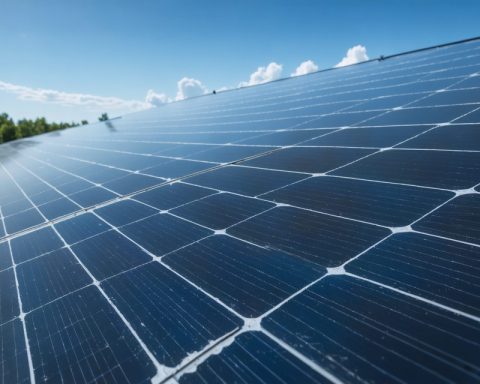- Sunnova Energy International navigates a volatile solar market, facing an 84% stock value drop in six months but focusing on growth through technology.
- Sunnova leverages AI for solar design enhancements and operational efficiency, addressing supply chain issues.
- The US solar market is poised to reach $103.96 billion by 2032, with current government incentives and mandates driving growth.
- Sunnova strategically increases its Investment Tax Credit to 42.2% by supporting US-made parts, significantly boosting cash flow.
- The company’s strategic ambition targets adding up to 120,000 customers by 2024, prioritizing profitable growth over volume.
- Sunnova’s blend of technology, strategic foresight, and sustainability marks a shift toward a resilient renewable energy future.
Bright sunlight cascades over rooftops adorned with gleaming solar panels, a testament to the evolving landscape of renewable energy. Amidst this transformation, Sunnova Energy International (NYSE:NOVA) emerges as both a stalwart and a challenger, caught in the fluctuating winds of the solar market. Despite facing a challenging year with a staggering 84% drop in stock value over six months, Sunnova is pioneering an audacious path forward, harnessing the power of technology and strategic foresight.
As a leading provider of residential solar systems across the United States, Sunnova has weathered the proverbial storm of economic shifts and pandemic-induced supply chain disruptions. Yet, beneath the surface of statistics lies their strategic ambition: integrating AI into solar design and maximizing financial incentives to fuel growth.
In 2023, the global solar market shimmered at $253.69 billion, with North America securing a commanding 41.3% share. Propelled by governmental incentives and renewable energy mandates, the US solar sector is on a trajectory to skyrocket to $103.96 billion by 2032. This expansive outlook underscores the immense potential that Sunnova seeks to capitalize on.
Technological advances reverberate through Sunnova’s strategy. By embracing AI diagnostics, the company seeks to refine its operations and enhance solar efficiencies, addressing supply chain vulnerabilities and advancing towards the goals laid out by international climate agreements. With a keen gaze on sustainability, Sunnova is slashing operations and maintenance costs, strategically positioning itself to benefit from lucrative tax credits.
Central to their maneuvering is the Investment Tax Credit (ITC), which Sunnova adeptly utilizes to bolster cash flow. By advocating for US-made parts, they’ve catapulted their ITC rate to an impressive 42.2%, with aspirations for further elevation. Each percentage point increase translates into tens of millions of dollars.
Aspiring to expand their customer base by up to 120,000 by the end of 2024, Sunnova is demonstrating a shift from mere volume acquisition to a focus on profitable growth. This strategic vision emphasizes their commitment to value over size, seeking not just to install panels but to transform rooftops into energy powerhouses.
Sunnova’s journey exemplifies a pivotal shift toward an electrifying horizon where technology, strategy, and sustainability converge. Their story is a reminder that in the ever-evolving tapestry of renewable energy, resilience matched with innovation can guide companies through turbulent times towards a sustainable future. While challenges remain, Sunnova’s bold embrace of technology foreshadows a new dawn in renewable energy.
Is Sunnova Energy’s Bold New Strategy the Future of Solar?
A Deeper Dive into Sunnova’s Strategic Direction
Sunnova Energy International stands at the intersection of challenge and opportunity in the renewable energy landscape. Despite facing a significant drop in stock value, the company’s forward-thinking strategy embodies resilience and innovation, targeting technological integration and strategic financial management to fuel growth.
Expanding on the Solar Market Overview
In 2023, the global solar market reached a staggering $253.69 billion, with North America claiming a robust 41.3% of the market share. This momentum is expected to bolster the US solar sector to approximately $103.96 billion by 2032, reflecting a compound annual growth rate (CAGR) of nearly 9%. link name.
Technology and Innovation at Sunnova
– AI-Driven Diagnostics: By integrating AI into solar system design and maintenance, Sunnova is poised to enhance operational efficiencies. This move not only addresses longstanding supply chain vulnerabilities but also aligns with broader climate agreements aiming for increased renewable reliance.
– Investment Tax Credit (ITC) Strategy: Sunnova leverages the ITC to improve cash flow, achieving a remarkable ITC rate increase to 42.2% by emphasizing US-manufactured components. This strategic use of tax credits represents a significant financial advantage, translating to tens of millions of dollars saved.
How-To Steps and Life Hacks
1. Maximizing Solar System Efficiency:
– Regular Maintenance: Schedule regular check-ups using AI diagnostics to ensure optimal performance.
– Component Upgrades: Use US-made parts to potentially enhance your ITC rate.
2. Boosting Energy Independence:
– Battery Storage: Pair solar panels with advanced battery storage to increase independence from the grid.
Addressing Pressing Questions
– Is Sunnova’s Stock Decline a Concern?
While the 84% drop is significant, it reflects broader market volatility. Sunnova’s strategic response, particularly its focus on AI and the ITC, suggests long-term resilience and growth prospects.
– How Does AI Improve Solar Efficiency?
AI helps analyze data for predictive maintenance and efficiency monitoring, leading to reduced operational costs and improved solar panel performance.
Market Forecast and Industry Trends
The solar industry’s trajectory indicates significant growth, driven by governmental mandates for renewable energy and innovation in solar technology. A key trend is the increasing move towards smart solar systems, leveraging AI and IoT (Internet of Things) for enhanced performance and energy management.
Pros and Cons Overview
Pros:
– Tax advantages yielding significant financial returns.
– Sustainable growth strategy with a focus on technological innovation.
– Expanding customer base while prioritizing profitability.
Cons:
– Vulnerability to market volatility, as seen in recent stock declines.
– Potential challenges in scaling AI technology across all operations.
Real-World Applications
Sunnova’s strategy of transforming rooftops into solar hubs can be directly implemented by homeowners seeking greater energy independence. By using AI to manage solar systems, homeowners can expect lower maintenance costs and optimized energy output.
Actionable Recommendations
– For Homeowners: Consider integrating AI tools for solar energy management to optimize efficiency and savings.
– For Investors: Look at longer-term growth prospects in the solar sector, particularly companies leveraging technology like Sunnova.
– For Industry Stakeholders: Embrace partnerships to enhance local manufacturing, which could leverage ITC incentives.
In summary, Sunnova’s approach provides a forward-looking blueprint for success amid the fluctuating solar market. By embracing innovation and maximizing financial tools, they exemplify how strategic foresight can drive sustainability and profitability.














